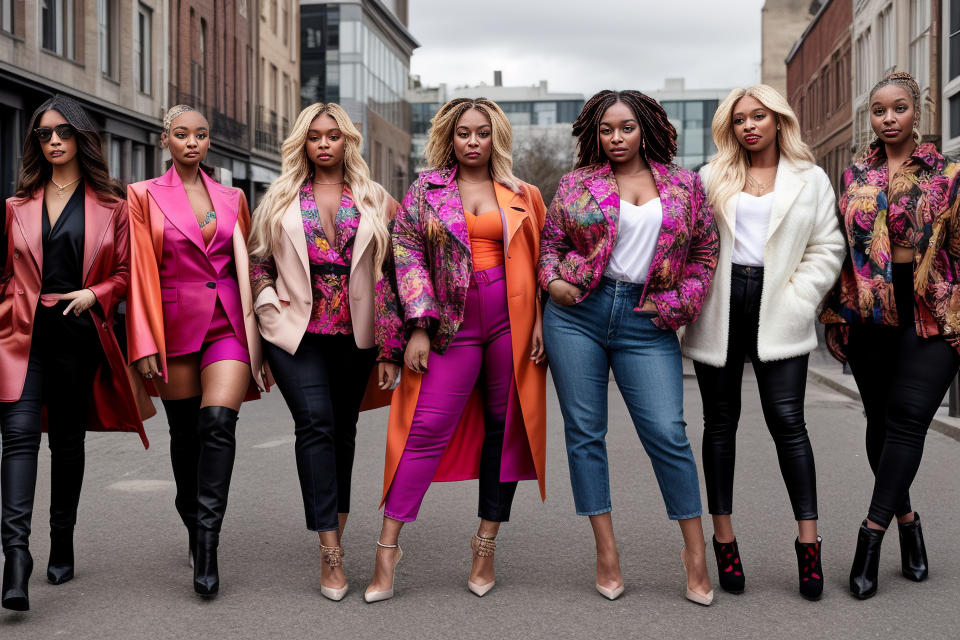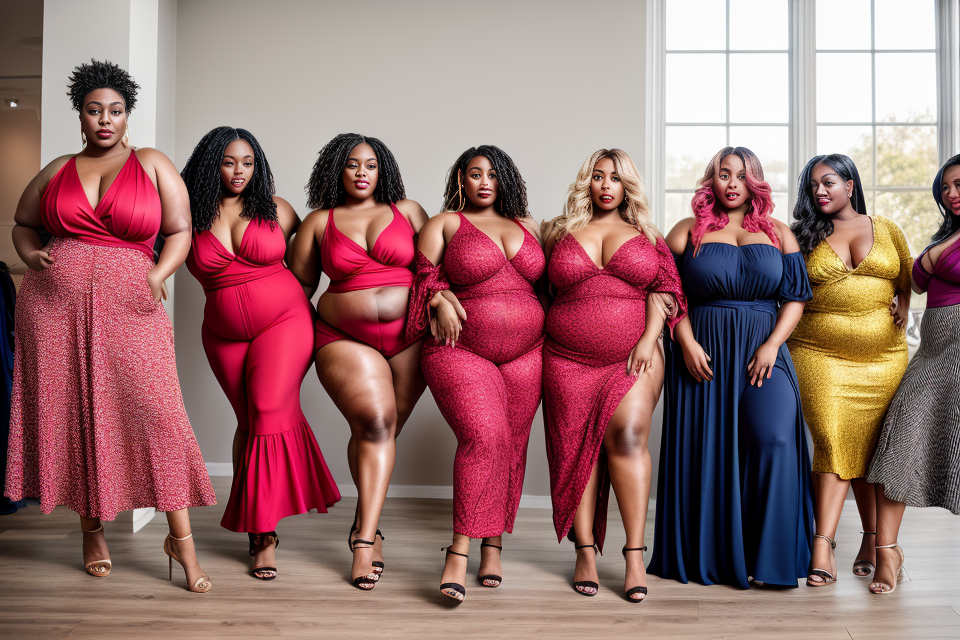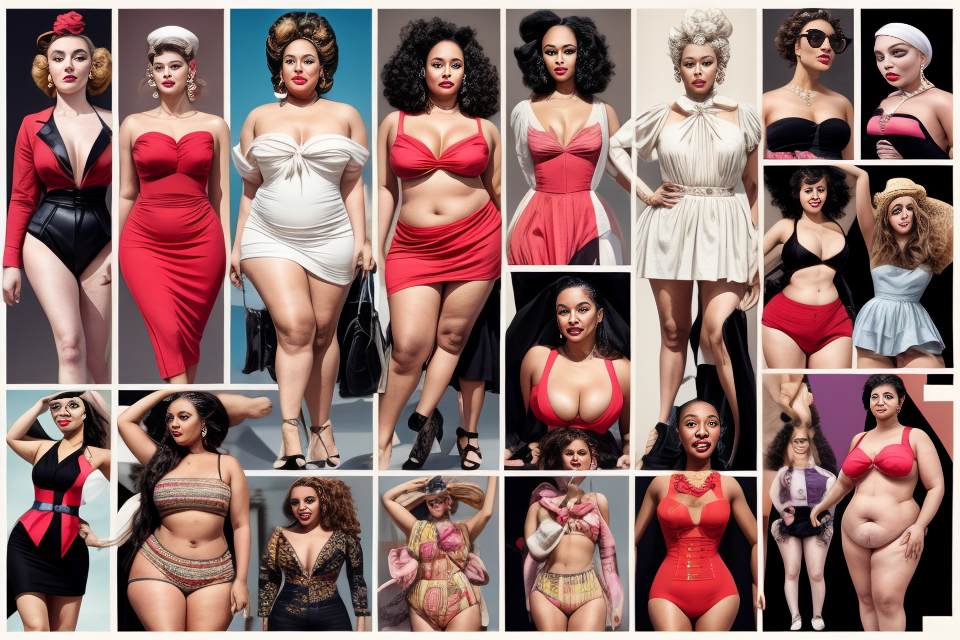The fashion industry has been a driving force in shaping societal perceptions of beauty and body image. From runways to magazines, the industry has long perpetuated a narrow and unrealistic standard of beauty, often leading to negative body image and self-esteem issues among individuals. In this article, we will explore the ways in which the fashion industry has impacted body image and the efforts being made to promote more inclusive and diverse representations of beauty. We will also discuss the importance of body positivity and self-love in the modern fashion landscape. So, let’s dive in and explore the complex relationship between fashion and body image.
The fashion industry has had a significant impact on body image, particularly in shaping societal expectations of beauty and attractiveness. Through the promotion of unrealistic and often unattainable beauty standards, the fashion industry has contributed to the development of negative body image and self-esteem issues among individuals. This has led to a rise in eating disorders, body dissatisfaction, and even mental health problems. On the other hand, the fashion industry has also been instrumental in promoting diversity and inclusivity in terms of body types, encouraging the acceptance of all shapes and sizes. However, the industry still has a long way to go in terms of promoting more realistic and achievable beauty standards, and in being more responsible in its portrayal of bodies in media and advertising.
The influence of fashion on societal beauty standards
The historical context of fashion and body image
The corset and the ideal waist
Throughout history, fashion has played a significant role in shaping societal beauty standards. One of the earliest examples of this is the corset, a garment worn to shape and mold the body into an hourglass figure. The corset was designed to cinch the waist and create the appearance of a small, defined waistline, which became the ideal silhouette during the 16th and 17th centuries. This fashion trend set the stage for the idea that a woman’s beauty was closely tied to her waistline, creating a standard that many women still strive for today.
The rise of the supermodel and the thin ideal
The 20th century saw a shift in the fashion industry, with the rise of the supermodel and the thin ideal. Supermodels like Twiggy and Kate Moss popularized a thin, boyish figure, which became the new standard of beauty. The fashion industry began to promote this ideal through advertising and runway shows, further entrenching the thin ideal in popular culture. This shift in fashion trends led to a new wave of body dissatisfaction and eating disorders, as women and men alike struggled to attain the unrealistic standards set by the fashion industry.
Despite the criticisms of the fashion industry’s impact on body image, it continues to hold a significant influence over societal beauty standards. As fashion trends continue to evolve, it remains to be seen whether the industry will embrace more inclusive and diverse ideals or continue to perpetuate harmful beauty standards.
The impact of social media on fashion and body image
The proliferation of unrealistic beauty standards
Social media has revolutionized the way people perceive and interact with fashion, creating a new digital landscape for fashion marketing and consumption. However, this has also contributed to the proliferation of unrealistic beauty standards, as platforms like Instagram and TikTok promote a narrow, often airbrushed, and unattainable aesthetic.
The influence of influencers on body image
Influencers, particularly those with large followings, wield significant power in shaping the public’s perception of beauty and fashion. They often serve as role models for their audience, and their posts can have a direct impact on their followers’ body image and self-esteem. While some influencers promote body positivity and diversity, others perpetuate harmful stereotypes and ideals, exacerbating existing body image issues.
As a result, the fashion industry has faced criticism for its role in promoting unrealistic beauty standards, which can lead to low self-esteem, body dissatisfaction, and eating disorders among vulnerable individuals. The industry must be mindful of its influence and work towards promoting a more inclusive, diverse, and realistic portrayal of beauty to mitigate the negative effects of social media on body image.
The impact of the fashion industry on individual body image
The psychological effects of the fashion industry on body image
The fashion industry has had a profound impact on how individuals perceive and think about their bodies. The psychological effects of the fashion industry on body image can be seen in several ways.
The relationship between fashion and low self-esteem
The fashion industry often promotes a certain standard of beauty that is often unattainable for most individuals. This can lead to feelings of low self-esteem and body dissatisfaction. People may feel like they are not good enough or do not measure up to the ideal beauty standards promoted by the fashion industry.
The role of body shaming in the fashion industry
Body shaming is a prevalent issue in the fashion industry. It is not uncommon for models to be subjected to harsh criticism and ridicule for their appearance. This can have a negative impact on an individual’s body image and lead to feelings of shame and inadequacy.
Additionally, the fashion industry often uses photo manipulation techniques to alter images of models, making them appear thinner or more flawless. This can further contribute to unrealistic beauty standards and a distorted view of one’s own body.
Overall, the psychological effects of the fashion industry on body image can be detrimental to an individual’s self-esteem and body satisfaction. It is important to recognize the impact of the fashion industry and work towards promoting more realistic and inclusive beauty standards.
The physical effects of the fashion industry on body image
The promotion of unrealistic beauty standards
The fashion industry has long been criticized for promoting unrealistic beauty standards that are often unattainable for most individuals. These standards are often perpetuated through the use of thin models and airbrushing techniques that erase any imperfections or signs of imperfection.
The promotion of unhealthy weight loss methods
One of the most significant physical effects of the fashion industry on body image is the promotion of unhealthy weight loss methods. The use of ultra-thin models and the pressure to maintain a certain weight or body shape can lead to dangerous behaviors such as extreme dieting, excessive exercise, and even eating disorders.
For example, a study conducted by the National Eating Disorders Association found that girls who reported being exposed to fashion magazines were more likely to engage in unhealthy weight control behaviors such as vomiting, fasting, and using diet pills. This can have serious consequences for physical health, including malnutrition, organ damage, and even death.
The negative effects of photoshop and airbrushing
Another way in which the fashion industry can negatively impact body image is through the use of photoshop and airbrushing. These techniques are often used to alter images of models and celebrities, removing any blemishes or wrinkles and enhancing their physical appearance.
This can create a false and unattainable standard of beauty that is nearly impossible for individuals to achieve. It can also contribute to a sense of inadequacy and low self-esteem, as individuals may feel that they cannot measure up to these unrealistic standards.
In conclusion, the physical effects of the fashion industry on body image are significant and far-reaching. From promoting unrealistic beauty standards to the promotion of unhealthy weight loss methods, the industry can have a profound impact on how individuals view and feel about their own bodies.
The pushback against unrealistic beauty standards in fashion
The rise of body positivity in the fashion industry
The body positive movement and its impact on fashion
The body positive movement has been a significant force in pushing back against unrealistic beauty standards in the fashion industry. This movement advocates for accepting and celebrating all body types, regardless of size or shape. The body positive movement has led to a shift in the way fashion is marketed and promoted, with brands and retailers increasingly embracing diversity and inclusivity in their advertising campaigns.
One notable example of this shift is the use of plus-size models in fashion campaigns. Brands such as Lane Bryant, H&M, and Sephora have all featured plus-size models in their advertising, which has helped to challenge traditional beauty standards and promote a more inclusive vision of beauty. Additionally, many fashion brands have started to offer a wider range of sizes, catering to customers who have traditionally been underserved by the industry.
The role of diversity and inclusivity in fashion
Diversity and inclusivity have become essential aspects of the fashion industry, as brands strive to create a more inclusive and representative environment. This includes casting models of diverse backgrounds and body types in fashion shows and advertising campaigns, as well as creating clothing lines that cater to a wide range of sizes and body types.
The fashion industry has also made strides in promoting diversity and inclusivity behind the scenes. For example, designers such as Chromat and Christian Siriano have been praised for their commitment to creating clothing that is accessible to all customers, regardless of their size or ability. Similarly, fashion publications have started to feature a wider range of models and body types in their editorial content, helping to challenge traditional beauty standards and promote a more inclusive vision of beauty.
Overall, the rise of body positivity in the fashion industry has led to a more inclusive and diverse environment, with brands and retailers increasingly embracing diversity and inclusivity in their advertising campaigns and product offerings. This shift has helped to challenge traditional beauty standards and promote a more positive and accepting view of all body types.
The challenges of promoting realistic beauty standards in fashion
The resistance to change in the fashion industry
The fashion industry has been criticized for promoting unrealistic beauty standards that often result in negative body image among individuals. Despite this, there is resistance to change within the industry, with some designers and brands still prioritizing a particular aesthetic over inclusivity and diversity.
One reason for this resistance is the fear of losing their market share. Designers and brands that have built their reputation on a particular aesthetic may worry that changing their approach could alienate their existing customer base. Additionally, there is a concern that embracing realistic beauty standards could make clothing and accessories less aspirational, leading to a decline in sales.
The impact of societal pressures on fashion and beauty standards
Societal pressures also play a role in the resistance to change in the fashion industry. Fashion is often seen as a reflection of cultural values and beliefs, and there is a fear that embracing realistic beauty standards could be seen as a rejection of these values. Additionally, there is a concern that promoting diversity and inclusivity could be seen as political correctness gone too far, leading to a backlash from consumers.
Despite these challenges, there are signs that the fashion industry is slowly beginning to embrace more realistic beauty standards. In recent years, there has been a greater focus on diversity and inclusivity, with more designers and brands casting models of different ages, races, and body types in their campaigns and runway shows. Additionally, there has been a push for more realistic representations of women in media, with the #NoFilter campaign encouraging brands to show their products on models with imperfections.
While progress has been slow, it is clear that the fashion industry is beginning to recognize the importance of promoting realistic beauty standards. By embracing diversity and inclusivity, the industry can help to promote a more positive body image among individuals, and ultimately create a more equitable and accepting society.
The future of fashion and body image
The potential for positive change in the fashion industry
The fashion industry has the potential to create positive change in the way that it shapes our understanding of body image. There are several factors that suggest that this could be the case.
The growing awareness of mental health and body image
One factor that suggests that the fashion industry could create positive change is the growing awareness of mental health and body image. In recent years, there has been a growing recognition of the link between fashion and mental health, and the ways in which the fashion industry can perpetuate harmful body ideals. This growing awareness has led to a call for change, with many in the industry recognizing the need to create a more positive and inclusive environment.
The shift towards sustainability and ethical fashion
Another factor that suggests that the fashion industry could create positive change is the shift towards sustainability and ethical fashion. As consumers become more aware of the environmental and social impact of the fashion industry, there is a growing demand for more sustainable and ethical practices. This shift towards sustainability has the potential to create a more positive body image, as it encourages a more inclusive and diverse approach to fashion.
Overall, the fashion industry has the potential to create positive change in the way that it shapes our understanding of body image. By addressing the issues of mental health and sustainability, the industry can create a more positive and inclusive environment that promotes body positivity and self-acceptance.
The challenges and uncertainties of the future
The future of fashion and body image is marked by challenges and uncertainties. As the industry continues to evolve, the potential for further negative impact on body image cannot be ignored.
The role of technology in shaping the future of fashion and body image
Technology has revolutionized the fashion industry, providing new opportunities for designers and consumers alike. With the rise of social media, virtual reality, and artificial intelligence, fashion is becoming increasingly accessible and personalized. However, this also means that the pressure to conform to unrealistic beauty standards is greater than ever.
The potential for further negative impact on body image
As technology advances, so does the potential for further negative impact on body image. The use of digital manipulation tools, such as Photoshop, has led to the unrealistic portrayal of models and celebrities in the media. This can have a harmful effect on the self-esteem and body image of young people, who may feel pressured to achieve an unattainable ideal.
Additionally, the rise of social media has created a platform for cyberbullying and body shaming, which can have devastating effects on mental health. As the fashion industry continues to embrace technology, it is crucial that it takes responsibility for promoting positive body image and diversity. Only time will tell how the industry will navigate these challenges and uncertainties in the future.
FAQs
1. How has the fashion industry impacted body image?
The fashion industry has had a significant impact on body image, particularly for women. The industry promotes a certain standard of beauty that is often unattainable and unrealistic, leading to low self-esteem and body dissatisfaction among many individuals. This standard is often portrayed through the use of thin models in advertisements and runway shows, which can create a distorted view of what is considered attractive.
2. What are some negative effects of the fashion industry on body image?
The negative effects of the fashion industry on body image include the promotion of unrealistic beauty standards, leading to low self-esteem, body dissatisfaction, and eating disorders. The industry often uses photo shopping and airbrushing to create an unattainable image of beauty, which can cause individuals to feel inadequate and ashamed of their bodies. Additionally, the use of ultra-thin models can perpetuate the idea that only a certain body type is attractive, leading to a lack of diversity and inclusivity in the industry.
3. How has the fashion industry changed in recent years in response to criticism of its impact on body image?
In recent years, there has been a growing movement towards more diversity and inclusivity in the fashion industry. Some designers and brands have begun to use models of different shapes, sizes, and races in their advertisements and runway shows, which can help to promote a more realistic and diverse view of beauty. Additionally, some fashion magazines have begun to feature articles and interviews with individuals who challenge traditional beauty standards, which can help to promote body positivity and self-acceptance.
4. What can individuals do to combat the negative effects of the fashion industry on body image?
Individuals can combat the negative effects of the fashion industry on body image by practicing self-love and self-acceptance. This can include avoiding media that promotes unrealistic beauty standards, practicing positive self-talk, and surrounding oneself with individuals who support and uplift each other. Additionally, supporting brands and designers that promote diversity and inclusivity can help to support a more positive and realistic view of beauty.



